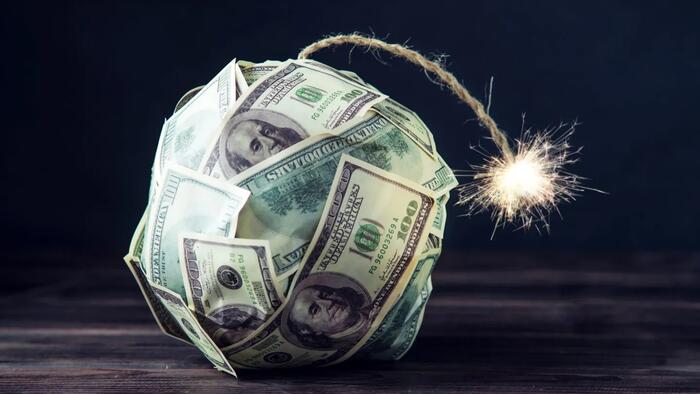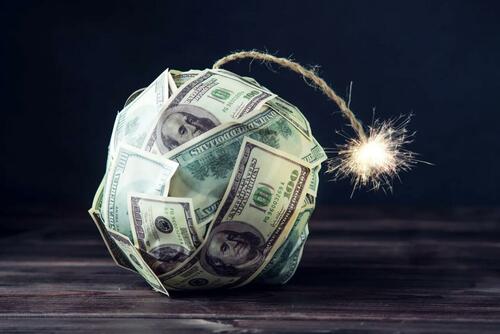


There are plenty of comments about the death of the US dollar as the world’s reserve currency. These tend to appear when the dollar index declines. However, these “dollar death” reports are greatly exaggerated and fail to answer a simple question: What is the alternative?
If you want to bet on the euro as a global reserve currency ahead of the imposition of the digital euro, which will obliterate all limits to central bank surveillance and excess, be my guest.
Furthermore, the enormous military spending and public expenditure plans that have been announced in 2025 add to the giant committed unfunded liabilities of member states, moving from 350% in the case of Germany to 500% of GDP in the case of Spain.
The Chinese yuan is only used in 4.5% of global transactions. With capital controls, exchange rate fixing and significant legal and investor insecurity due to government control of institutions, it is difficult to believe that China’s yuan will be an alternative to the US dollar. Additionally, I do not believe that the Chinese government wants to eliminate those barriers and, as such, has no desire to be a world reserve currency. This is a similar problem with the currency of Brazil, Russia, India, or South Africa. Would you accept your salary and savings in a currency issued by countries with capital controls as well as significant legal and investor security challenges?
Gold and bitcoin are reserve-value alternatives to fiat currencies for investors but cannot replace the US dollar due to the low liquidity and supply.
Currently, we are observing a decline in the value of the dollar as investors take on more risk, following the euro’s collapse to nearly parity in 2024 and the yen’s drop to 40-year lows against the US dollar. This is driven by the Federal Reserve’s stubborn rate policy.
How is the Fed responsible for a weaker dollar?
For international investors, buying US treasuries can be uneconomical due to the large hedging costs created by elevated US rates. At the same time, rates are plummeting in Europe, making it more reasonable to purchase European assets and debt despite the weak fundamentals and solvency. Fearing a non-existent inflation burst, the Fed is engineering a dollar decline by maintaining high rates.
One can criticise tariffs for a variety of reasons, but they don’t trigger inflation. Tariffs do not create more units of currency in the system and do not drive higher monetary velocity. What causes inflation is government spending and money printing. Furthermore, those that fear tariff impacts on prices never consider the elevated levels of overcapacity in the export world, the complexity of supply chains, or the working capital challenges created by not exporting to the United States.
Even with all the negative headlines and the Fed’s negative impact, the US dollar index is significantly above where it was in 2009-2018 and is only reflecting a short bounce of the euro and yen (73% of the index).
The dollar index (DXY) is at 98.5 at the close of July 18th. The DXY averaged approximately 93.15 during Obama’s presidency and 100.0 through Biden’s tenure. Furthermore, the Broad Trade-Weighted Dollar Index is at 120.35. It averaged 98 during Obama and 118 with Biden. It is hard to call the current level “a collapse”.
Higher US rates and carry trade bets are driving a typical risk-on bounce.
A set of structural, institutional, and market realities support the dollar’s dominance, despite frequent calls for de-dollarization or speculation about emerging alternatives.
1. Deep and Liquid Financial Markets
2. Trusted Legal and Institutional Frameworks
3. Global Trade and The Network Effect
To be a world reserve currency, alternatives must have open markets, full capital account convertibility, legal transparency, and sizable, investable assets. There is no alternative to the US dollar with these criteria. The euro faces redenomination risk and the imposition of the central bank digital euro and lacks a truly unified fiscal policy. The Chinese yuan is constricted by capital controls, state intervention, and a less open legal system.
The US dollar’s status as a world reserve currency remains because there is no fiat alternative. Gold and Bitcoin may be investment options, but they do not fulfil the functions or trust needed at a global level.
The only risk for the United States is that all the benefits of having the world reserve currency become enormous liabilities if confidence is lost due to fiscal indiscipline. However, the fiat world is not about who wins but who loses first.
No fiat currency can be an alternative to the US dollar if the government is more fiscally imprudent, institutions are less independent and capital markets less open than in the United States.
What saves the US dollar from losing its status as a world reserve currency is that the fiscal, legal and economic situation of the alleged alternatives is even worse.
The U.S. dollar remains the world reserve currency because it has no contenders. This is not because the government and Federal Reserve policies are always sound, but because others are much worse. The greatest threat to the dollar’s dominance is internal: fiscal and trade deficits and political dysfunction. Yet, unless and until another currency can match the US dollar’s unparalleled combination of depth, trust, liquidity, and legal robustness, the dollar’s primacy endures. You cannot dethrone the US dollar by being worse than the king.
It is sad, but true. The dollar’s biggest strength is the atrocious monetary, legal and fiscal irresponsibility of its alternatives.

